Étiquette : Guido Cantelli

Cadences/Cadenzas: Ferrucio Busoni
Walter Gieseking, Baldwin piano – Guido Cantelli New York Philharmonic (NYPO)
Carnegie Hall – March 6, 1955
Source: Bande / Tape – 19 cm/s / 7.5 ips
Cette interprétation du 6 octobre 1955 documente la rencontre entre Gieseking et Cantelli. C’est le retour de Gieseking avec le NYPO pour la première fois depuis 1939, et c’est une réussite. L’influence réciproque entre les deux interprètes conduit à une interprétation mémorable qui est on ne le peut mieux décrite que par le critique américain Bernard H. Haggin (1900-1987) dans son article de 1968 en hommage à Cantelli:
‘A l’époque, j’ai trouvé que beaucoup d’interprétations de Cantelli étaient merveilleuses; et merveilleux est le mot pour certaines que j’ai entendues récemment, en particulier celle du Concerto pour piano de Mozart K.467. Dans mon expérience, seul Toscanini apportait aux solistes des contextes orchestraux aussi beaux et aussi efficaces que ceux de Cantelli; et dans mon expérience, Toscanini a fourni le précédent pour la chose extraordinaire qui se passe dans l’interprétation par Cantelli du concerto K.467. A un concert du New York Philharmonic en 1934, j’ai entendu Toscanini diriger les concertos K.467 et K.466 avec José Iturbi en soliste, et j’ai entendu Iturbi—sous l’impulsion de la personnalité et du magnétisme du chef—rivaliser avec le jeu puissant de l’orchestre avec un jeu personnel qui était remarquablement différent de son jeu embelli habituel, un style de salon, pour jouer Mozart.
Et la même chose se produit dans l’exécution par Cantelli du concerto K.467. Ce que l’on s’attend à entendre après l’introduction orchestrale superbement exécutée est le style miniature finement ciselé pour jouer Mozart que l’on entend toujours de la part de Gieseking; mais ce que l’on entend à la place, ce sont une énonciation forte et des phrasés forts pour jouer la mélodie, et des doigtés forts pour les séquences de notes rapides et les figurations qui doivent avoir surpris Gieseking comme ils doivent avoir surpris ses auditeurs en 1955 au concert du New York Philharmonic. Jamais auparavant, il n’avait joué Mozart comme cela; et il l’a fait sous la même impulsion de la part de Cantelli que celle que Toscanini avait exercé sur Iturbi. Sous cette impulsion, Iturbi a réussi, et Gieseking réussit, dans l’extraordinaire Andante ce que je n’ai entendu d’aucun autre pianiste au concert: une énonciation et une articulation de la longue cantilène du piano qui soit comparable avec l’enregistrement discographique de Schnabel. Et le jeu de Gieseking dans cette cantilène, contrairement à celui de Schnabel, s’exprime dans le contexte du jeu superbe de la partie orchestrale qui est constamment active—par exemple, les commentaires poignants des bois qui intensifient certaines des énonciations du piano.’

![]()

This October 6, 1955 concert illustrates the meeting between Gieseking and Cantelli. It is Gieseking’s return with the NYPO for the first time since 1939 and it is a success. The reciprocal influence between both musicians leads to a memorable performance best described by US critic Bernard H. Haggin (1900-1987) in his 1968 tribute to Cantelli:
‘Many of Cantelli’s performances I found marvelous at the time; and marvelous is the word for those I have heard recently—in particular the one of Mozart’s Piano Concerto K.467. Only Toscanini, in my experience, provided soloists with orchestral contexts as beautifully made and as effective as Cantelli’s; and Toscanini provided the one precedent in my experience for the astounding thing that happens in Cantelli’s performance of K.467. At a New York Philharmonic concert in 1934, I heard Toscanini perform K.467 and 466 with José Iturbi as soloist, and heard Iturbi—under the compulsion of the personality and magnetism of the man on the podium—match the orchestra’s powerful playing with playing of his own that was strikingly different from his customary prettified salon-style playing of Mozart.
And the same thing happens in Cantelli’s performance of K.467. What one expects to hear after the superbly performed orchestral introduction is the finely chiseled miniature-scale playing of Mozart that one always heard Gieseking do; but what one hears instead is a strongly enunciated, strongly phrased playing of melody, a strong-fingered execution of runs and figuration, that may have amazed Gieseking as it must have amazed his listeners at the New York Philharmonic concert in 1955. He had never played Mozart that way before; and he did so then under the same compulsion from Cantelli as Toscanini had exercised on Iturbi. Under that compulsion, Iturbi achieved, and Gieseking achieves, in the extraordinary Andante what I have heard live from no other pianist: an enunciation and articulation of the piano’s long cantilena comparable with Schnabel’s in his recorded performance. And Gieseking’s playing of this cantilena, unlike Schnabel’s, is heard in the context of the superb playing of the constantly active orchestral part—e.g., the poignant woodwind comments intensifying certain of the piano’s statements.’
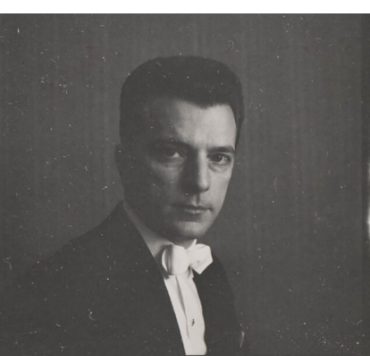
Brahms: Tragische Ouverture Op.81 NBC SO Manhattan Center – January 15, 1951
Brahms: Symphonie n°1 Op.68 NBC SO – Carnegie Hall – December 6, 1952
______
NYPO – Westminster Choir – Carnegie Hall – April 1, 1956
Verdi: Te Deum
Brahms: Alt-Rhapsodie Op.53 NYPO – Martha Lipton
Source: Bande/Tape 19 cm/s / 7.5 ips
Guido Cantelli a peu donné en concert l’Ouverture Tragique de Brahms Op.81, mais par contre sa Première Symphonie Op.68 est l’œuvre qu’il a le plus dirigé. Fin 1950, la NBC a transformé en studio de TV le studio 8-H où avaient lieu la plupart des concerts du NBC SO, et a décidé de les transférer au Manhattan Center, salle à l’acoustique très réverbérée, ce que Toscanini a refusé, seul Carnegie Hall étant pour lui acceptable, et donc seuls d’autres chefs d’orchestre, dont Cantelli, y ont donné temporairement des concerts avec cet orchestre, et la NBC n’a finalement pu que se plier à sa demande.
Le Te Deum de Verdi et la Rhapsodie pour contralto, chœurs d’homme et orchestre Op.53 de Brahms ont été mis au programme des concerts des 29, 30, 31 mars, et 1 avril 1956 du New York Philharmonic et c’est la seule fois qu’il les a dirigées.


Guido Cantelli has seldom performed Brahms’ Tragic Overture Op.81, whereas his first Symphony Op.68 was the work he most conducted. At the end of 1950, the NBC transformed Studio 8-H where most of the NBC SO concerts were given, into a TV studio, and decided to tranfer them to Manhattan Center, a venue with much reverberation, which Toscanini refused, only Carnegie Hall being acceptable to him, and thus only other conductors, among them Cantelli, temporarily gave concerts there with this orchestra and eventually the NBC had to comply with his demand.
Verdi’s Te Deum and Brahms’ Rhapsody for contralto, male chorus and orchestra Op.53 were performed at the New York Philharmonic concerts of March 29, 30, 31 and April 1, 1956 and it it the only time he performed them.
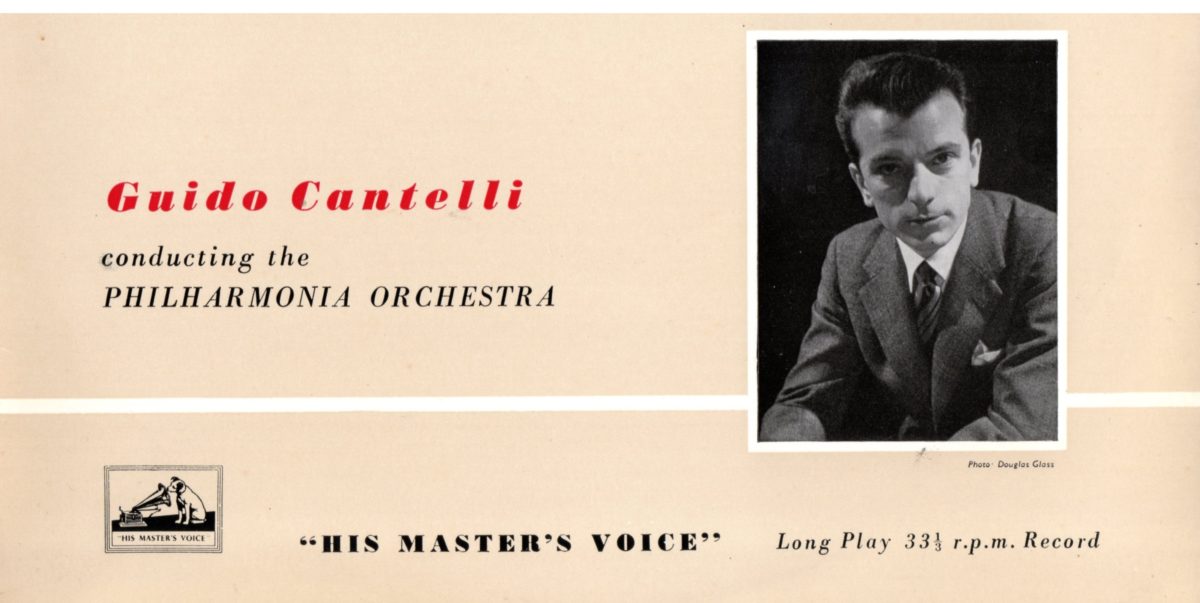
NBC SO Carnegie Hall – 15 December 1951 (Bande/Tape)
_________
Philharmonia Orchestra – 8, 9, 12, 16 &18 August 1955 (GHLP 1004-Mono)
La Troisième Symphonie est réputée comme étant la Symphonie de Brahms la plus difficile à interpréter. Si des chefs comme Walter ou Furtwängler ont signé des versions considérées comme des références, elle a posé beaucoup de problèmes même à de grands brahmsiens, à commencer par Toscanini qui, dans ses témoignages enregistrés, ne l’a vraiment réussie qu’avec le Philharmonia Orchestra, en concert à Londres au Royal Festival Hall en 1952.
C’était par contre une des grandes interprétations de Guido Cantelli qui en a laissé trois témoignages enregistrés (NBC SO, Boston SO, Philharmonia Orchestra).
L’enregistrement réalisé pour HMV/EMI à Kingsway Hall en 1955 a été capté à la fois en monophonie et en stéréophonie expérimentale. A cet effet , il y avait deux équipes de prises de son. L’enregistrement stéréophonique n’a été publié qu’en 1978, et depuis, c’est cette seule version qui est rééditée. Toutefois, en comparant ces deux captations, on constate qu’avec l’étalement en largeur de l’orchestre procuré par la stéréo, la réverbération de Kingsway Hall tend à diluer les timbres et à lisser les phrasés, alors que la prise de son mono, bénéficiant d’un judicieux placement microphonique qui permet à l’acoustique ample de la salle de porter pleinement le son de l’orchestre, est bien mieux définie: l’interprétation sonne de manière nettement plus vivante, et les timbres et les détails du phrasé sont mieux restitués. Avec la version mono, on est aussi musicalement plus proche de la version enregistrée en concert avec le NBC SO.
Le tableau des minutages ci-dessous montre qu’en studio avec le Philharmonia, et comme c’était en général le cas avec Cantelli, les tempi sont plus larges. Il montre aussi qu’en concert, Cantelli faisait la reprise (environ 3′) dans le premier mouvement, mais que cette reprise est malheureusement omise dans l’enregistrement commercial avec le Philharmonia.
Minutages/Timings:
NBC SO 15 Dec. 1951 (12’23; 7’57; 5’35; 8’06)
Boston SO 25 Dec. 1954 (12’28; 7’58; 5’45; 8’02)
NYPO 20 Jan. 1955 (12’40; 7’45; 5’40; 8’10)
Philharmonia Orch Aug. 1955 (9’57; 8’43; 6’18; 8’25)
[Philharmonia Orch Toscanini 1 Oct 1952 (12’27; 8’31; 6’17; 8’34)]
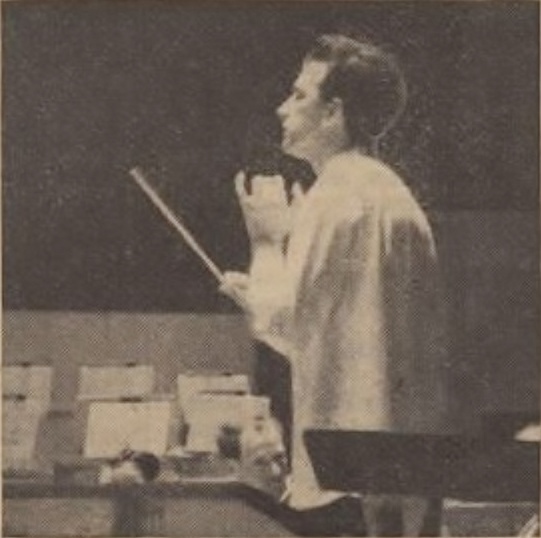
Cantelli Philharmonia Edinburgh
Among the Brahms Symphonies, the Third Symphony is considered as being the most difficult to perform. If conductors like Walter or Furtwängler have made recordings considered as references, it proved problematic even for great Brahms conductors, and for Toscanini to start with, who in his recorded testimonies was only successful with his 1952 London concert in Royal Festival Hall with the Philharmonia Orchestra.
On the other hand, it was one of the great performances of Guido Cantelli who left three recordings (NBC SO, Boston SO, Philharmonia Orchestra).
The 1955 recording for HMV/EMI in Kingsway Hall was made both in mono and in experimental stereo. For this purpose, there where two recording teams. The stereophonic version was published only in 1978, and since then, is the only one to be re-issued. However a comparison between both reveals that, because of the Kingsway Hall reverberation, the spreading in width of the orchestra brought by stereophony goes with a lower definition of the timbres and a smoothing of the phrasings, whereas the mono version, because of a well chosen microphone placement that allows the warm hall acoustics to bring a full-blooded orchestral sound, has much more definition: the performance sounds much more alive, and the timbres and the details of phrasing are better reproduced. With the mono version, we are also musically closer to the concert performance recorded with the NBC SO.
The timings (see above) show that in studio with the Philharmonia, and as was generally the case with Cantelli, the tempi are broader. They also show that, in live performances, Cantelli made the first movement repeat (about 3′), but that this repeat was omitted in the commercial recording with the Philharmonia.
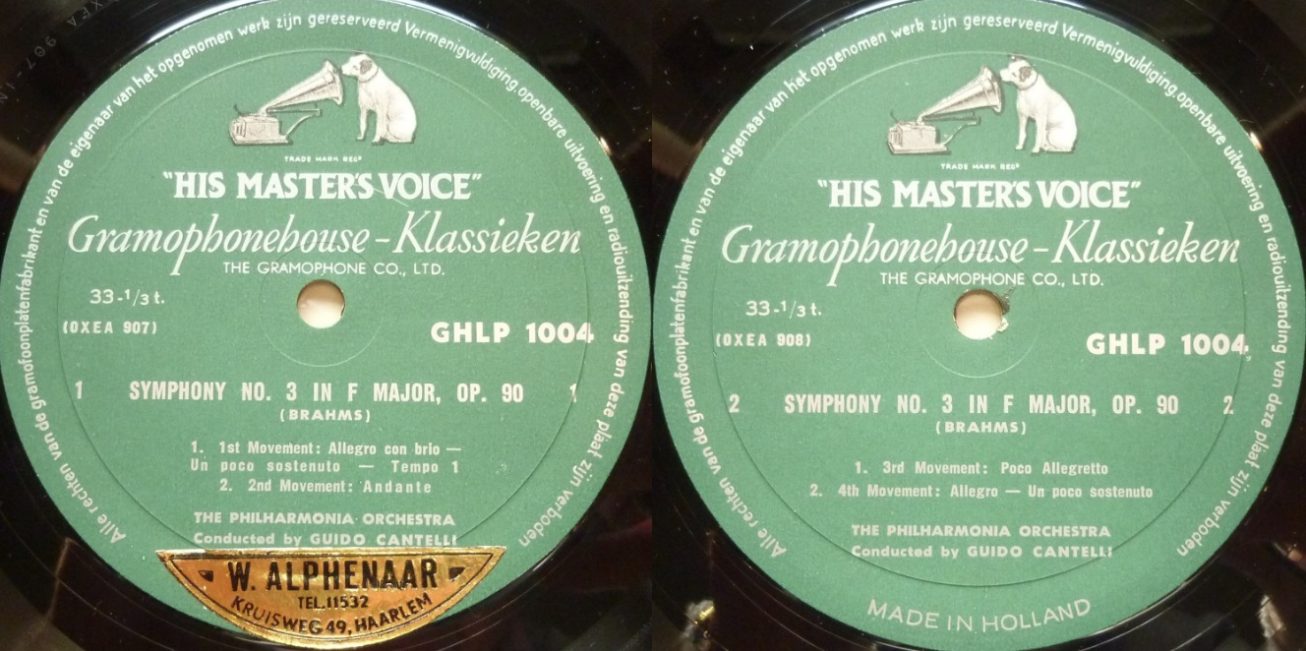
Meilleurs Vœux pour 2022 avec/ Best Wishes for 2022 with:
Rossini
Il Signor Bruschino – NYPO Carnegie Hall 29 mars 1953
Cenerentola – NBC SO Carnegie Hall 14 février 1954
Semiramide – BSO Boston Symphony Hall 31 janvier 1953
_____
Verdi La Forza del Destino NBC SO Carnegie Hall 2 février 1952
Wagner Faust-Ouvertüre NYPO Carnegie Hall 22 mars 1953
Source: Bande/Tape 19 cm/s / 7.5 ips
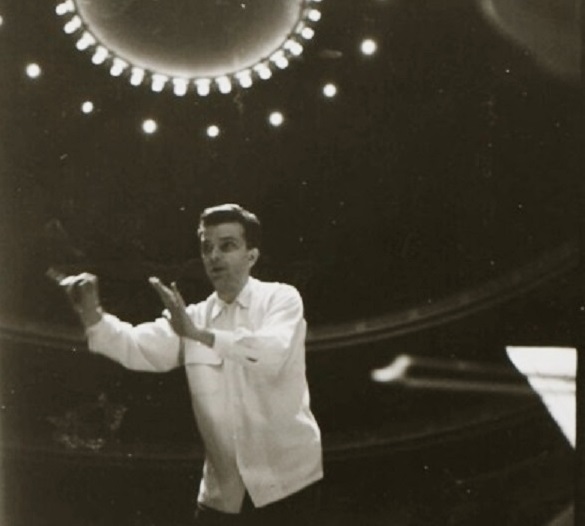
Voici pour débuter cette année cinq ouvertures interprétées avec trois orchestres (New York Philharmonic; NBC Symphony Orchestra; Boston Symphony Orchestra) pour lesquelles les interprétations de Cantelli se situent dans le droit fil de Toscanini. On notera cependant qu’il y a ici plus de respiration et de souplesse, et que l’enthousiasme y est celui de la jeunesse. Mais Toscanini lui-même ne disait-il pas de Cantelli que c’était lui quand il était jeune?
L’ouverture qu’il a le plus jouée était Semiramide, depuis le Festival d’Edimbourg 1950 (le 6 septembre) avec l’orchestre de la Scala: il en reste un bref extrait de 3’45 filmé en répétition à Usher Hall (pour un extrait d’une minute, cliquer ICI ), jusqu’à son tout dernier concert le 17 novembre 1956 à Novara avec ce même orchestre.
_____________
For the beginning of this New Year, here are five Overtures performed with three orchestras (New York Philharmonic; NBC Symphony Orchestra; Boston Symphony Orchestra) in which Cantelli’s performances are in line with Toscanini’s. There are, it is worth noting, more breathing and flexibility, and the enthusiasm is that of youth. But didn’t Toscanini himself say that Cantelli was like himself when he was young?
The Overture he performed most was Semiramide, since the 1950 Edinburgh Festival (September, 6) with the Scala Orchestra, of which remains a short filmed 3’45 rehearsal excerpt shot in Usher Hall (click HERE for one minute thereof), until his very last concert on November, 17, 1956 in Novara, with the same orchestra.
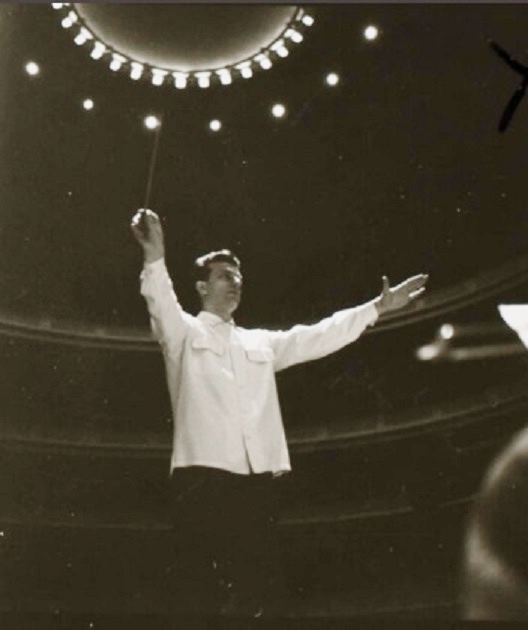
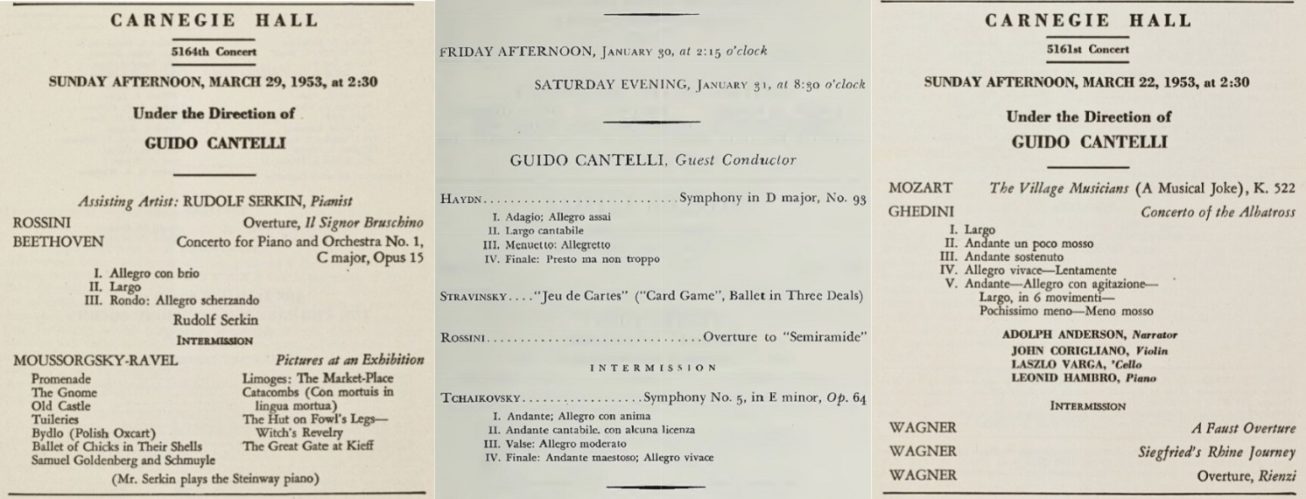
Guido Cantelli: NYPO March 29, 1953 – BSO Jan. 30 & 31, 1953 – NYPO March 22, 1953
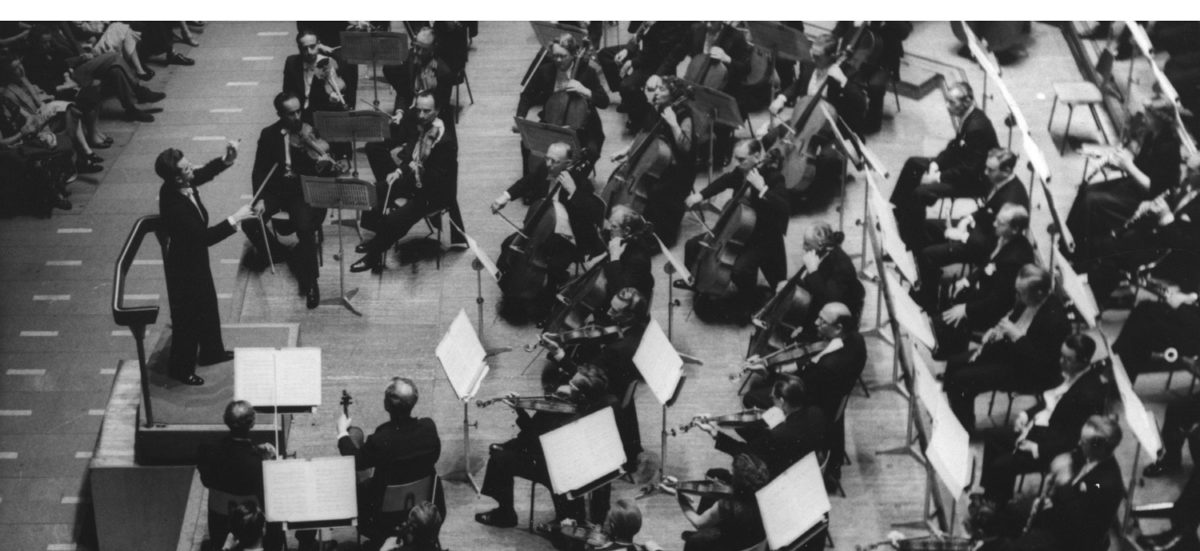
Guido Cantelli
Source: Bande/Tape 19 cm/s / 7.5 ips
I – Philharmonia Orchestra – London Kingsway Hall May 15 & 21, 1953
Manoug Parikian, violin
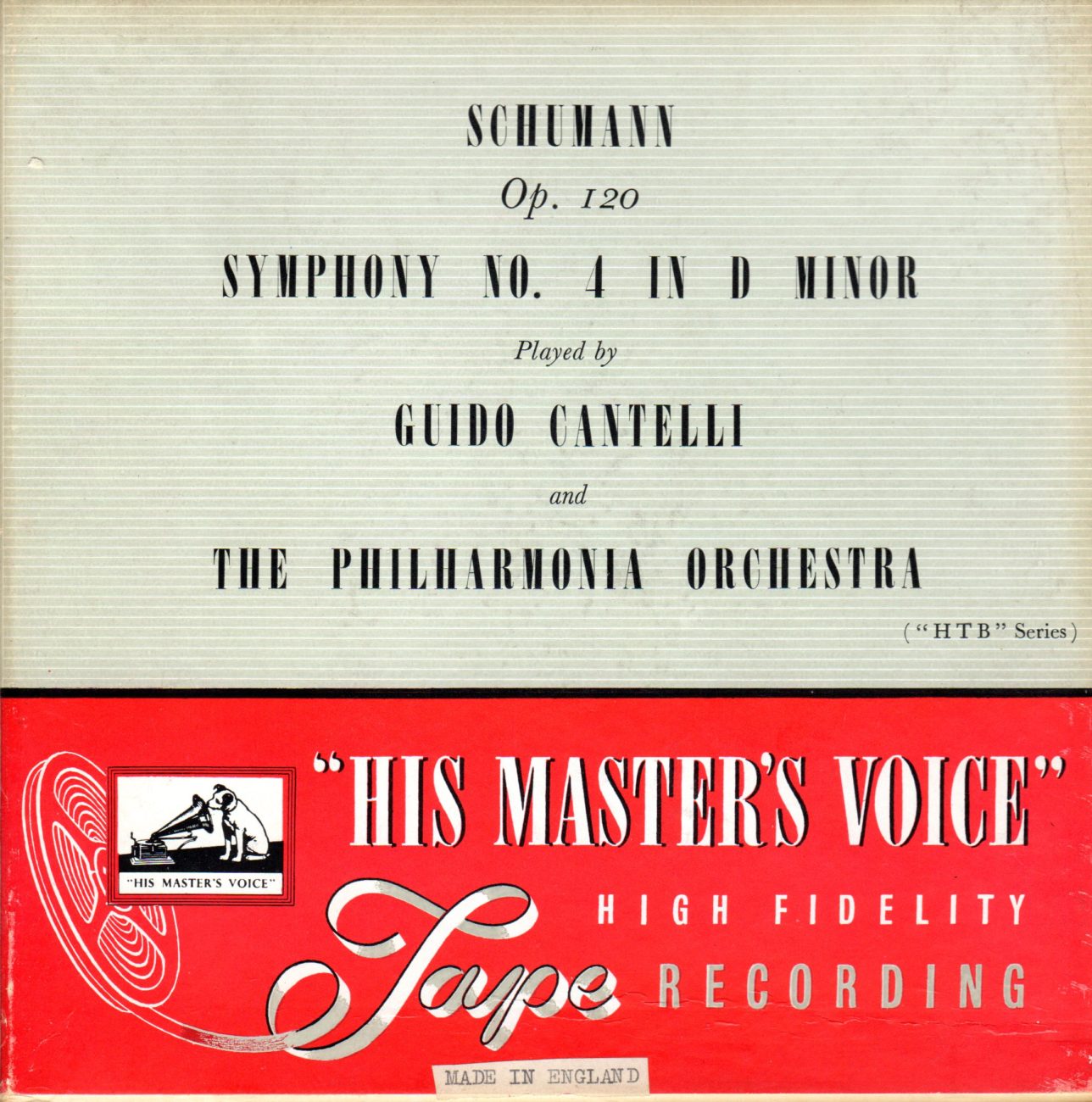


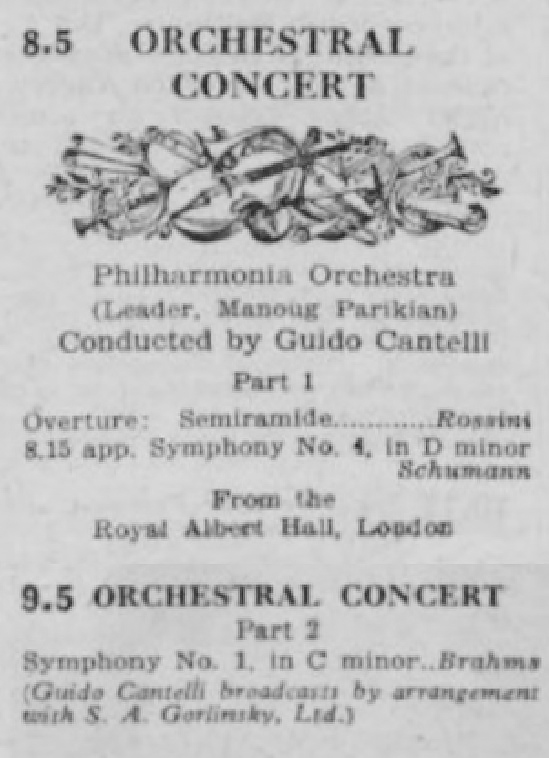
Concert du 11 mai 1953 (BBC Third Program)
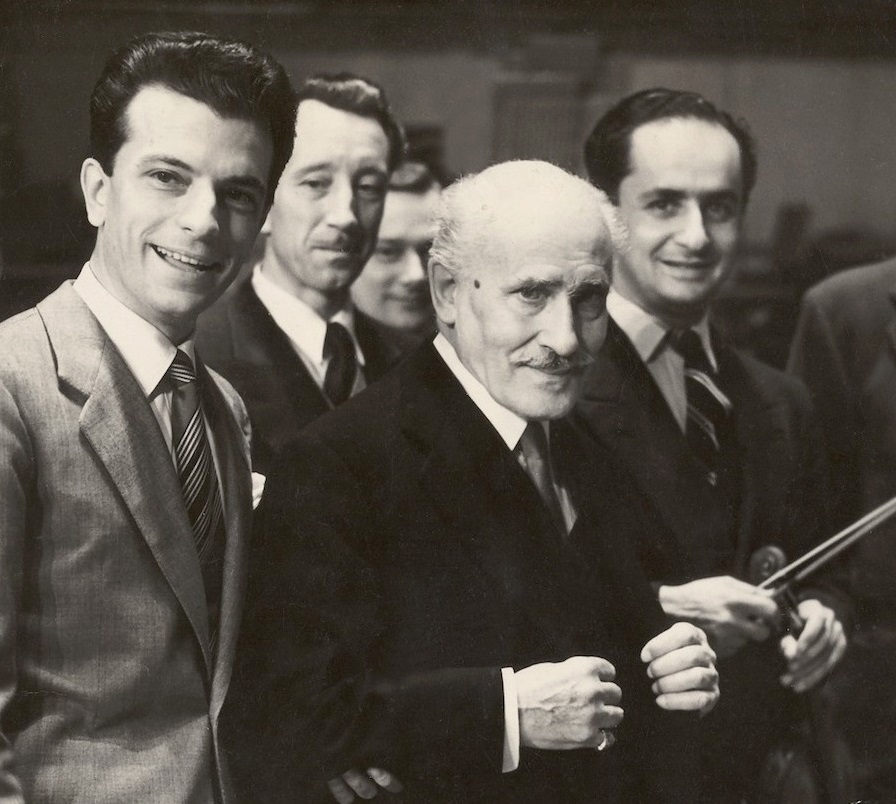
Guido Cantelli Herbert Downes Arturo Toscanini Manoug Parikian
La Quatrième de Schumann: une des grandes interprétations de Guido Cantelli. Son enregistrement avec le Philharmonia, réalisé peu après un concert au Royal Albert Hall (et quasiment en même temps que celui de Furtwängler), est ici reproduit à partir d’un exemplaire en bon état de la bande commercialisée sous la référence HTB 401. Quant à la version en public avec le NYPO, elle matérialise la seule série de concerts où il l’a programmée avec cet orchestre, et aussi son ultime vision de cette œuvre, assez différente de celle avec le Philharmonia, mais tout aussi passionnante.
____________
Schumann Symphonie n°4 – Cantelli Concerts (* = concert radiodiffusé/broadcast concert):
Orchestra del Teatro alla Scala: 12/11/ 1954 (Brescia); NBC SO: 29/11/1952*; NYPO: 15, 16, 18*, 24/3/1956; BSO: 6, 7*/2/1953; WPO: 9/8/1953* (Salzburg); Philharmonia: 11/5/1953* (CD ICAC 5143); 9/9/1954* Edinburgh (CD ICAC 5081)
____________
The Schumann Fourth: one of the great interpretations by Guido Cantelli. His recording with the Philharmonia, made soon after a concert at Royal Albert Hall (and almost at the same time as Furtwängler’s), is reproduced here from a copy in good condition of the HTB 401 commercial tape. As to the live version with the NYPO, it materializes the only concert week when he performed it with this orchestra, and also his last vision of this work, rather different from the one with the Philharmonia, but as thrilling.
II – NYPO New York Carnegie Hall – March 18, 1956
John Corigliano, violin
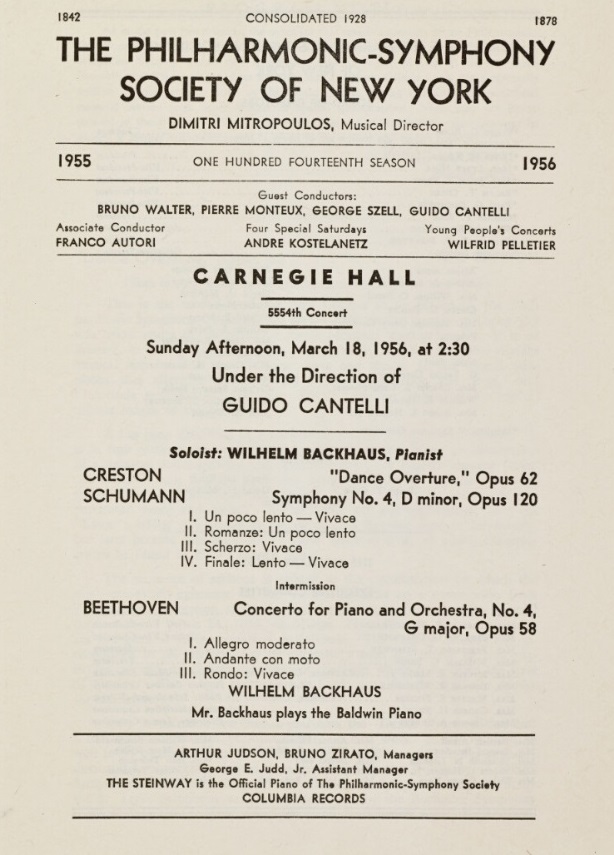
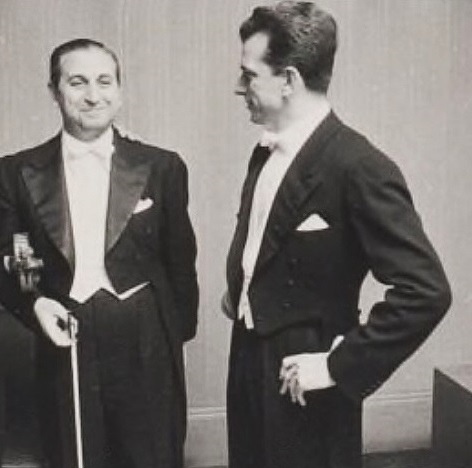
John Corigliano Guido Cantelli
Les liens de téléchargement sont dans le premier commentaire. The download links are in the first comment.



